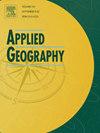More vibrant neighborhood, better quality of life? Examining pathways connecting neighborhood liveliness and subjective well-being
IF 4
2区 地球科学
Q1 GEOGRAPHY
引用次数: 0
Abstract
In response to rapid and uneven urban expansion, planners have increasingly emphasized the creation of lively and accessible neighborhoods that support quality of life. Neighborhood liveliness—the intensity of human activity in local environments—has emerged as a key dimension of urban livability, yet its relationship to subjective well-being (SWB) remains underexplored. Using geo-tagged spatial data and survey data collected from Beijing in 2018, the study explores the potential mechanisms linking neighborhood liveliness and SWB. Structural equation modeling (SEM) is employed to examine both direct and indirect effects, with a focus on mediating factors including perceived neighborhood attributes, active travel behavior, and neighborhood satisfaction. The results reveal that neighborhood liveliness has a positive direct effect on life satisfaction, but its impact on affective well-being is indirect, operating through encouraged active travel. Notably, excessive liveliness is also associated with reduced perceived aesthetics, highlighting trade-offs. These findings underscore the importance of designing behaviorally engaging urban environments and adopting a multidimensional planning approach that considers the complex interplay between spatial activity, mobility, and well-being.
更有活力的社区,更好的生活质量?研究连接社区活力和主观幸福感的途径
为了应对快速而不均衡的城市扩张,规划者越来越强调创造充满活力和便利的社区,以支持生活质量。社区活力——当地环境中人类活动的强度——已成为城市宜居性的一个关键维度,但其与主观幸福感(SWB)的关系仍未得到充分探讨。利用2018年在北京收集的地理标记空间数据和调查数据,研究了社区活力与SWB之间的潜在联系机制。采用结构方程模型(SEM)研究了直接和间接影响,重点研究了感知邻里属性、主动出行行为和邻里满意度等中介因素。结果表明,社区活力对生活满意度有直接正向影响,但对情感幸福感的影响是间接的,通过鼓励积极出行来实现。值得注意的是,过度的活力也与降低的感知美学有关,突出了权衡。这些发现强调了设计具有行为吸引力的城市环境和采用多维规划方法的重要性,该方法考虑了空间活动、流动性和福祉之间复杂的相互作用。
本文章由计算机程序翻译,如有差异,请以英文原文为准。
求助全文
约1分钟内获得全文
求助全文
来源期刊

Applied Geography
GEOGRAPHY-
CiteScore
8.00
自引率
2.00%
发文量
134
期刊介绍:
Applied Geography is a journal devoted to the publication of research which utilizes geographic approaches (human, physical, nature-society and GIScience) to resolve human problems that have a spatial dimension. These problems may be related to the assessment, management and allocation of the world physical and/or human resources. The underlying rationale of the journal is that only through a clear understanding of the relevant societal, physical, and coupled natural-humans systems can we resolve such problems. Papers are invited on any theme involving the application of geographical theory and methodology in the resolution of human problems.
 求助内容:
求助内容: 应助结果提醒方式:
应助结果提醒方式:


